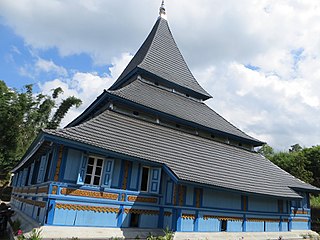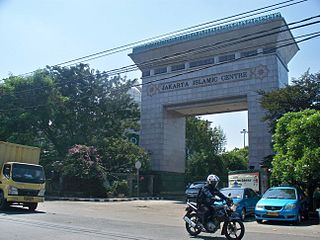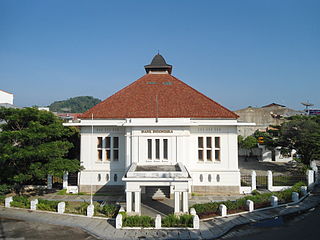
Istiqlal Mosque in Jakarta, Indonesia is the largest mosque in Southeast Asia and the ninth largest mosque in the world in terms of worshipper capacity. Built to commemorate Indonesian independence, this national mosque of Indonesia was named "Istiqlal", an Arabic word for "independence". The mosque was opened to the public on 22 February 1978. Within Jakarta, the mosque is positioned next to Merdeka Square, the Jakarta Cathedral (Catholic), and also of the Immanuel Church (Reformed).

North Jakarta is one of the five administrative cities which form Special Capital Region of Jakarta, Indonesia. North Jakarta is not self-governed and does not have a city council, hence it is not classified as a proper municipality. It contains the entire coastal area within the Jakarta Special Capital Region. North Jakarta, along with South Jakarta is the only two cities in Jakarta to border Banten and West Java. It is also the only two cities and regencies of Jakarta with a coastline and not landlocked along with the Thousand Islands Regency. North Jakarta, an area at the estuary of Ciliwung river was the main port for the kingdom of Tarumanegara, which later grew to become Jakarta. Many historic sites and artefacts of Jakarta can be found in North Jakarta. Both ports of Tanjung Priok and historic Sunda Kelapa are located in the city. The city, which covers an area of 139.99 km2, had 1,645,659 inhabitants at the 2010 census and 1,778,981 at the 2020 census; the official estimate as at mid 2022 was 1,793,550 - comprising 905,575 males and 887,975 females. It has its administrative centre in Tanjung Priok.

The Mīqāt Dhu al-Ḥulayfah, also known as Masjid ash-Shajarah or Masjid Dhu al-Hulayfah, is a miqat and mosque in Abyār ʿAlī, Medina, west of Wadi al-'Aqiq, where the final Islamic prophet, Muhammad, entered the state of ihram before performing 'Umrah, after the Treaty of Hudaybiyyah. The mosque is located 7 km (4.3 mi) SW of the Al-Masjid an-Nabawi and was defined by Muhammad as the miqat for those willing to perform the Hajj or Umrah pilgrimages from Medina. It is the second-largest miqat mosque after the Miqat Qarn al-Manazil in As-Sayl al-Kabir.

Sawahlunto is a city in West Sumatra, Indonesia. It lies 90 kilometres from Padang, the provincial capital. Sawahlunto is known as the site for the oldest coal mining site in Southeast Asia. Sawahlunto is geographically located in a narrow valley along the Bukit Barisan mountains and surrounded by several hills, namely Bukit Polan, Bukit Pari, and Bukit Mato. The town has a land area of 273.45 sq. km, and had a population of 56,866 at the 2010 Census, 60,136 at the 2015 Census, and 65,138 at the 2020 Census; the official estimate as at mid-2022 was 66,413 - comprising 33,430 males and 32,983 females.

The Great Mosque of Palembang, also known as Sultan Mahmud Badaruddin I Great Mosque after the former Sultan of Palembang, is the main mosque of Palembang, the capital of South Sumatra. The mosque is the largest in South Sumatra, and the third largest mosque in Sumatra after the Grand Mosque of West Sumatra and Great Mosque of Pekanbaru.

The Great Mosque of Malang is a mosque located in Malang, Indonesia. The mosque was built in 1890 and completed in 1903, making it one of the oldest mosques in Indonesia. The mosque is square-shaped, constructed with steel, and has a tajug on top. The original building is still maintained today.

Rao Rao Mosque is one of the oldest mosques in Indonesia located in Nagari Rao Rao, Tarab River, Tanah Datar Regency, West Sumatra. It is located on the road from Batusangkar bound to Bukittinggi, precisely in Rao Rao. This mosque of Minangkabau and Persian architecture was built in 1908 with a roof made from fibers before being changed to zinc.

The Bingkudu Mosque is one of the oldest mosques in Indonesia. It was founded by the Padri in the wake of the Padri War in West Sumatra in 1823. This mosque with typical Minangkabau style architecture is located in Jorong Bingkudu, Nagari Canduang Koto Laweh, Canduang District, Agam Regency, West Sumatra. When it was first built, the building of the mosque was made of wood on its floor, pole, and wall.
Dian Al-Mahri Mosque, also known as Golden Dome Mosque(Masjid Kubah Emas), is a mosque built on the edge of Raya street, Depok City in West Java, Indonesia. In addition to being a place of daily worship for Muslims, this mosque area attracts many locals and tourists because its domes are made of gold. Because of the vastness of the area and its accessibility to the public, this place is often a holiday destination for family or a place to take a rest.

Jami Mosque of Taluak is one of the oldest mosques in Indonesia, located in Taluak IV Suku Nagari, Banuhampu District, Agam Regency, West Sumatra. The location of the mosque is close to the border of Bukittinggi, thus it is also known as Jamik Taluak Mosque Bukittinggi.

Koto Baru Grand Mosque is one of the oldest mosques in Indonesia located in Koto Baru Nagari, Sungai Pagu District, South Solok Regency, West Sumatra.
Mutaqaddimin Mosque is an old mosque in Indonesia, located in Jorong Kapalo Tangah, Andaleh Nagari, Luhak District, Lima Puluh Kota Regency, West Sumatra. The mosque was built in 1930, making it the oldest mosque in Andaleh Nagari area.

Jakarta Islamic Centre (JIC) is a center for Islamic studies and research in Koja, Jakarta, Indonesia. Activities of JIC include ZISWAF empowerment, education, socio-economic activities, regular recitations, Tabligh Akbar, and celebrations of Islamic holidays.
The Al-Anshor Mosque is arguably the oldest mosque in Jakarta, Indonesia. It is located at Pekojan, Tambora, Jakarta and was built in 1648.

Tuo Kayu Jao Mosque is an old mosque in Indonesia that is located in Jorong Kayu Jao, Batang Barus Nagari, Gunung Talang District, Solok Regency, West Sumatra. The existence of the mosque was already recorded in 1599, making it the oldest mosque in Solok Regency and among the oldest surviving mosques in Indonesia.

Nurul Huda Mosque is one of the oldest mosques in Indonesia, located in Baringin District, Sawahlunto, West Sumatra. The mosque, built during the Dutch occupation, has a rectangular building with a tower blending into the main building. Currently, in addition to a function as a place of worship for Muslims, this two-story mosque is also used as a means of religious education for the surrounding community.
Willem Hendrik de Greve was a Dutch geologist. He was known for his discovery of the coal mine in Sawahlunto, Dutch East Indies.

Bank Indonesia Museum of Padang is a former bank building located in Padang, Indonesia. The building was built on March 31, 1921 as the Padang branch office of De Javasche Bank before it was taken over by Bank Indonesia on July 1, 1953.

The Nurul Iman Mosque is a mosque located at the corner of Jalan Imam Bonjol and Jalan Muhammad Thamrin in Padang, Indonesia. The mosque was built by the Indonesian National Armed Forces and the national government, as a gesture of apology following a West Sumatran rebellion in 1960.


























